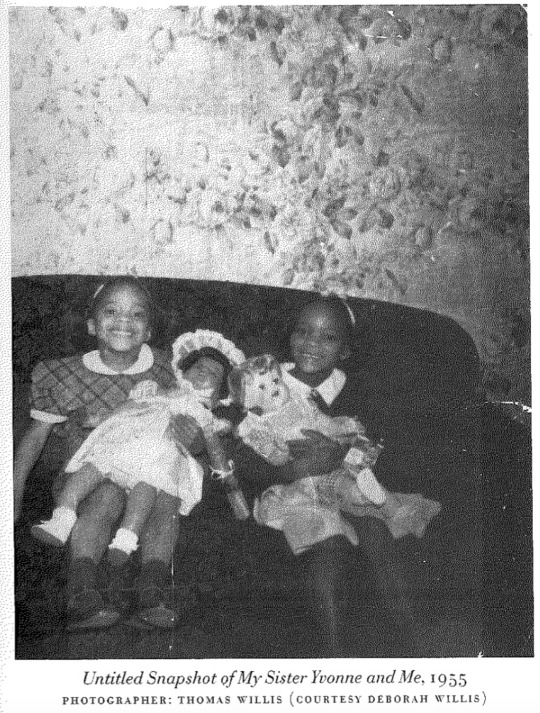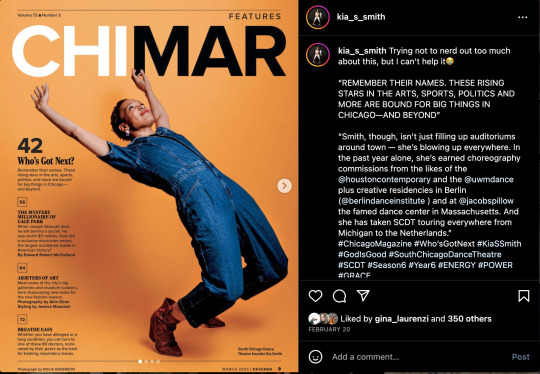Don't wanna be here? Send us removal request.
Text
Journal Summary
In this blog, I discuss the TV show Dear White People, the movie Parasite, and the artistic director of South Chicago Dance Theatre, Kia Smith. Overall, this blog is a discussion of understanding complexity through compassion. Stereotypes about race and ethnic identity are incredibly prevalent in America and are typically caused by the foundation of white supremacy the United States was built on. By putting ourselves in another person’s shoes, whether that be a TV show, a movie, or a social media account, we can find threads of relatability that can create compassion for one another, for a kinder, more diverse country and society.

Kia Smith of South Chicago Dance Theatre https://chicagoreader.com/arts-culture/dance/kia-smith-is-a-south-side-diplomat-of-dance/
0 notes
Text
Blog Post 3: Social Media
For my social media selection, I chose to look at Kia Smith. She is the founder and artistic director of the contemporary dance company, South Chicago Dance Theatre. Smith’s great-grandmother moved to Chicago during the Great Migration, and Smith’s family lived there ever since (Paul). Given that her family was moving during the Great Migration, they likely were sharecroppers and possibly former slaves, as discussed in Takaki’s writing (317). She earned her Masters of Fine Arts in Dance from the University of Wisconsin-Milwaukee in 2018, and I have personally met and worked with her through the Department of Dance’s guest artist program.

A photo of sharecroppers https://www.history.com/topics/black-history/sharecropping
Racism is very prevalent in the dance community, especially in contemporary. The roots of contemporary and modern dance tie in many elements of African dance, however they are often unrepresented and unacknowledged. Kia Smith is making massive changes in the American dance community by raising her voice along with other black voices to make dance a more equitable and inclusive space. As Smith herself said, “people haven’t had the education to actually understand how much the [African] diaspora has influenced dance and music in American and around the world but more people need to see other people’s perspectives... how we can be more empathetic, compassionate, and equitable if we allow ourselves to learn about others,” (South Chicago Dance Theatre).

Deborah Willis and her sister (Willis 5).
Smith is also an important dance artist for young girls to look up to. I can speak to my own experience, being an overly tall plus-sized dancer, I had no one to look up to who looked like me growing up in the dance world, I cannot imagine how hard it would have been to be a young Black girl with no one to look up to. Smith is on the cover of magazines, newspapers, and web articles dressed to the nines, and although it may not be her specific intention, she is also proving the beauty of Black women through this process. Maybe if Deborah Willis’ sister had seen Black women on the cover of magazines, she would not have internalized racism to the point that she would prefer a white doll over a Black one (Willis 5).


Two posts by Smith, one showing her on the cover of a magazine, one discussing her blossoming dance company featuring a photo of her in the center.
Finally, Smith is a leader of Chicago’s south side community, with her company “bring[ing] in artists from all over the world to our organization, but we’re rooted in the city’s south side, so I make sure that everything that we do is pouring into the community,” and she takes her company on a tour of local schools to perform during Black History Month (Paul).

A post by Smith about Black leaders, featuring Smith in the bottom right corner.
South Chicago Dance Theatre: https://www.southchicagodancetheatre.com/artisticdirector/
Paul: https://chicagoreader.com/arts-culture/dance/kia-smith-is-a-south-side-diplomat-of-dance/
Smith's Instagram: https://www.instagram.com/kia_s_smith/
0 notes
Text
Blog Post 2: Movie
My movie choice for this course was the Korean movie Parasite (2019) directed by Bong Joon-Ho starring Cho Yeo-jeong, Choi Woo-shik, and Park Seo-joon. This movie follows a family struggling through dire finnancial straits as they slowly infiltrate the home of a wealthy family, pretending to be tutors in art and English, a driver, and a housekeeper. Through this process, they put everyone who previously had those jobs (other than the English tutor) out of a job. Halfway through the film, the infiltrating family finds and even poorer family living in a secret basement of the wealthy family’s house and the infiltrating family attempts to get rid of them so they can keep their position within the house. The film culminates with a child’s birthday party where one member of the infiltrating family is beaten over the head with a rock, one is stabbed in the chest, the man from the basement is killed, and the father of the wealthy family is killed.

A movie poster for Parasite https://mubi.com/notebook/posts/movie-poster-of-the-week-the-posters-of-parasite
Culturally, Parasite is one of very few foreign language films to reach popularity in the United States. However, it truly made history and generated conversation at the Oscars, when it won best picture, the most prestigious award. Parasite was the first non-English language film to win the title in the nearly 100-year history of the award. Parasite also won best director, best original screenplay, and best international film, making it the most decorated film to come out of that particular award ceremony (Giorgis). Personally, I first saw Parasite shortly before the Oscar’s and it was the first foreign language film I ever watched, and has since become one of my favorite movies of all time. As the director, Bong Joon-ho said, “once you overcome the 1-inch-tall barrier of subtitles, you will be introduced to so many more amazing films,” (Chang).

Director Bong Joon-Ho holding two of his Oscars for Parasite https://slate.com/culture/2020/02/parasite-oscar-win-best-picture-bong-joon-ho.html
Another layer of Parasite’s success in America is that is featured an exclusively Korean cast, and challenged the common American stereotype of the model minority. As discussed throughout Grace Lee, asian women are often seen as meek, nice, and intelligent, and are not seen as complex human beings. Parasite offers deeply rich and complex characters at every social class in a way that many Americans, including myself, probably had not seen before. Further, Joon-ho's work revealed that life in Korea is not so different than America in terms of different classes are treated. This creates a level of relatability that can soften into a more diverse understanding of Asian culture and Asian-Americans.
Finally, here is the video of Parasite winning best picture at the Oscars:
youtube
Giorgis: https://www.theatlantic.com/culture/archive/2020/02/parasite-oscars/606310/
Chang: https://www.theatlantic.com/culture/archive/2020/02/parasite-oscars/606310/
0 notes
Text
Blog Post 1: Television Show
Note: Excluding captions this post is within the word limit with 486 words total.
For my television show, I chose to watch season one of the Netflix Original Dear White People (2017-2021) created by Justin Simien. The show is set at a fictionalized Ivy League school called Winchester University and follows of wide cast of Black characters as they navigate a historically white, wealthy, and elitist landscape. This relates to the course because each episode highlights the history and experiences of one of those peers, which weave together to create a rich and deeply complex window into what it means to be Black in 2010s America.

Sam (left) and Colandrea (right) have a terse conversation in Dear White People (Chapter IV 4:40).
In season 1 episode 4, where we follow the forming and crumbling of Sam’s friendship with her freshman year roommate, Colandrea. In the earliest flashback of Colandrea’s character, it shows her at a preschool or day care being given free time to play with toys. Colandrea tries to pick the white doll to play with, but instead another Black peer rips it from her hands and tells her “No, you take the ugly one,” and hands her a Black doll (Chapter IV 1:30). This vividly reminded me of the first photo Deborah Willis included in her introduction to Picturing Us of her and her sister with dolls they picked out for Christmas, Willis with a Black doll and her sister with a white one (Willis 5). Willis goes on to describe how in scientific studies where young children are asked to choose between a white and a Black doll, “the majority of African American children... indicated an overwhelming preference for the white doll and a rejection of the brown doll,” highlighting the presence internalized racism even at a young age (Willis 6). This scene of the show generates conversation about race in that it highlights how racism is so deeply ingrained into the fabric of our society that children as young as preschool feel shame about their physical appearance and identity and see themselves as less than white people.

Willis and her sister with their dolls (Willis 5).
This internalized racism follows Colandrea into her college life as she tries to fit in with her white peers while Sam struggles to fit in with other Black students. At one point Colandrea even jokes to Sam, “Dear half-white person, you’re just not Black enough for the [Black Student] Union,” (Chapter IV 9:50). Sam’s situation is quite like what I read about Hapas, and many other mixed raced people struggling with—how to embody their identity. Specifically, one Hapa in Fulbeck worked with wrote that he is “Black Japanese, Japanese Black either, or, both, all at the same time,” showing that he, like many mixed-race individuals felt pressure from society to choose one identity or another rather than being able to embody a complex identity (Fulbeck). This scene generates conversation about race in that it captures how they often feel like cannot properly connect with any side of their heritage. In Sam’s case, she is too white for Black people and too Black for white people.

A handwritten reflection on being a Hapa pulled from Fulbeck's website https://kipfulbeck.com/hapa-me/
1 note
·
View note